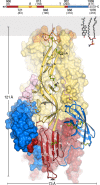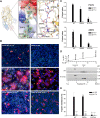Crystal Structure of Glycoprotein C from a Hantavirus in the Post-fusion Conformation
- PMID: 27783673
- PMCID: PMC5081248
- DOI: 10.1371/journal.ppat.1005948
Crystal Structure of Glycoprotein C from a Hantavirus in the Post-fusion Conformation
Abstract
Hantaviruses are important emerging human pathogens and are the causative agents of serious diseases in humans with high mortality rates. Like other members in the Bunyaviridae family their M segment encodes two glycoproteins, GN and GC, which are responsible for the early events of infection. Hantaviruses deliver their tripartite genome into the cytoplasm by fusion of the viral and endosomal membranes in response to the reduced pH of the endosome. Unlike phleboviruses (e.g. Rift valley fever virus), that have an icosahedral glycoprotein envelope, hantaviruses display a pleomorphic virion morphology as GN and GC assemble into spikes with apparent four-fold symmetry organized in a grid-like pattern on the viral membrane. Here we present the crystal structure of glycoprotein C (GC) from Puumala virus (PUUV), a representative member of the Hantavirus genus. The crystal structure shows GC as the membrane fusion effector of PUUV and it presents a class II membrane fusion protein fold. Furthermore, GC was crystallized in its post-fusion trimeric conformation that until now had been observed only in Flavi- and Togaviridae family members. The PUUV GC structure together with our functional data provides intriguing evolutionary and mechanistic insights into class II membrane fusion proteins and reveals new targets for membrane fusion inhibitors against these important pathogens.
Conflict of interest statement
The authors have declared that no competing interests exist.
Figures







References
-
- Hallin GW, Simpson SQ, Crowell RE, James DS, Koster FT, Mertz GJ, et al. Cardiopulmonary manifestations of hantavirus pulmonary syndrome. Critical care medicine. 1996;24(2):252–8. - PubMed
-
- Hughes MT, Gonzalez JA, Reagan KL, Blair CD, Beaty BJ. Comparative potential of Aedes triseriatus, Aedes albopictus, and Aedes aegypti (Diptera: Culicidae) to transovarially transmit La Crosse virus. J Med Entomol. 2006;43(4):757–61. Epub 2006/08/09. - PubMed
-
- Lee HW, Lee PW, Johnson KM. Isolation of the etiologic agent of Korean Hemorrhagic fever. The Journal of infectious diseases. 1978;137(3):298–308. - PubMed
-
- Svedmyr A, Lee HW, Berglund A, Hoorn B, Nystrom K, Gajdusek DC. Epidemic nephropathy in Scandinavia is related to Korean haemorrhagic fever. Lancet. 1979;1(8107):100. - PubMed
-
- Brummer-Korvenkontio M, Vaheri A, Hovi T, von Bonsdorff CH, Vuorimies J, Manni T, et al. Nephropathia epidemica: detection of antigen in bank voles and serologic diagnosis of human infection. The Journal of infectious diseases. 1980;141(2):131–4. - PubMed
MeSH terms
Substances
Grants and funding
LinkOut - more resources
Full Text Sources
Other Literature Sources
Miscellaneous

